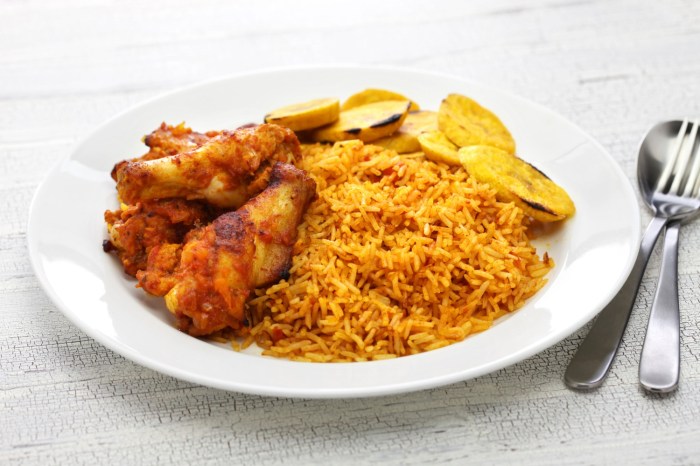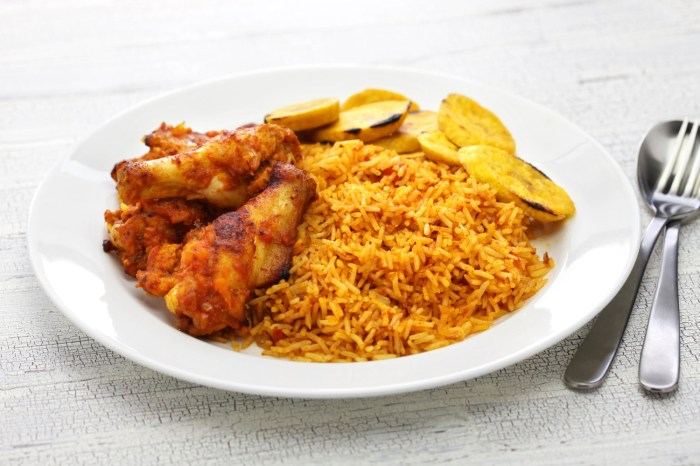
Nigerian Jollof Rice with Chicken and Fried Plantains: A Flavorful Journey
Nigerian Jollof Rice with Chicken and Fried Plantains is a culinary masterpiece that embodies the vibrant flavors and rich traditions of West African cuisine. This iconic dish, often the centerpiece of celebratory meals and family gatherings, is a symphony of textures and aromas that tantalizes the taste buds and transports you to the heart of Nigeria.
Jollof rice, a staple in many West African countries, is a dish that has evolved over centuries, incorporating diverse influences and local ingredients. In Nigeria, it’s a culinary icon, beloved for its savory, slightly spicy, and deeply satisfying flavor profile.
The combination of tender chicken, fluffy rice infused with a rich tomato-based sauce, and the sweet and crispy fried plantains creates a culinary experience that is both comforting and exciting.
Introduction to Nigerian Jollof Rice

Nigerian Jollof rice is a beloved dish that holds a special place in the hearts and stomachs of Nigerians and those who have had the pleasure of experiencing its vibrant flavors. It’s a testament to the country’s rich culinary heritage, showcasing a delightful blend of spices, textures, and colors.
This dish is much more than just a meal; it’s a symbol of cultural identity, a staple at social gatherings, and a source of pride for Nigerians worldwide.
The Origins and Cultural Significance of Nigerian Jollof Rice
The origins of Nigerian Jollof rice are deeply rooted in the country’s diverse culinary traditions. It’s believed to have originated in the 19th century, possibly in the coastal regions of the country, where trade with European nations introduced rice as a staple food.
As the dish spread throughout the country, different regions developed their own unique variations, incorporating local ingredients and flavors. Nigerian Jollof rice is more than just a meal; it’s a symbol of national pride and a dish that brings people together.
It’s often prepared for special occasions, such as weddings, birthdays, and religious festivals, where it serves as a centerpiece on the dining table. It’s also a common dish enjoyed at family gatherings, picnics, and potlucks, creating a sense of shared culinary heritage and community.
Chicken Preparation
The chicken is the star protein in this dish, adding a savory and flavorful element to the jollof rice. You can prepare the chicken in several ways, each contributing its own unique taste and texture to the final dish.
Nigerian jollof rice with chicken and fried plantains is a classic dish that always brings back fond memories of family gatherings. The vibrant red rice, infused with spices and simmered with tender chicken, is a true culinary delight. I always find myself reaching for a tangy condiment to complement the richness of the dish, like the legendary grandma slatterys michigan sauce , which adds a delightful sweet and spicy kick.
Whether you’re enjoying a hearty bowl of jollof rice or a simple snack, the combination of flavors is sure to satisfy.
Methods for Marinating and Cooking Chicken, Nigerian jollof rice with chicken and fried plantains
The marinade plays a crucial role in enhancing the flavor of the chicken. It infuses the meat with a blend of spices and herbs, creating a delicious and aromatic base for the dish. Here are some popular methods for marinating and cooking chicken:
- Grilling: This method delivers a smoky and charred flavor to the chicken, adding a unique dimension to the dish. You can marinate the chicken with a blend of spices, herbs, and citrus juice, and grill it over medium heat until cooked through.
- Frying: Frying the chicken results in a crispy exterior and juicy interior, providing a delightful contrast in textures. You can marinate the chicken in a flavorful mixture of spices, herbs, and garlic, and then pan-fry it in oil until golden brown and cooked through.
- Roasting: Roasting chicken in the oven allows for even cooking and creates a tender and succulent result. You can marinate the chicken with a blend of spices, herbs, and onions, and roast it in a preheated oven until cooked through.
Flavorful Chicken Marinade
Here is a recipe for a flavorful chicken marinade that complements the jollof rice:
Ingredients:* 1 cup plain yogurt
- 1/4 cup lemon juice
- 2 tablespoons olive oil
- 1 tablespoon paprika
- 1 tablespoon ground ginger
- 1 tablespoon garlic powder
- 1 teaspoon cumin
- 1 teaspoon salt
- 1/2 teaspoon black pepper
- 1/4 teaspoon cayenne pepper (optional)
Instructions:
- In a bowl, whisk together all the ingredients until well combined.
- Add the chicken pieces to the marinade and ensure they are completely coated.
- Cover the bowl and refrigerate for at least 30 minutes or up to 2 hours, allowing the flavors to infuse into the chicken.
Incorporating Chicken into Jollof Rice
After marinating, the chicken can be cooked separately using any of the methods described above. Once cooked, the chicken is typically shredded or diced and then added to the jollof rice, ensuring that the flavors meld together beautifully. The chicken adds a rich and savory element to the dish, creating a satisfying and flavorful meal.
Variations and Regional Differences: Nigerian Jollof Rice With Chicken And Fried Plantains
Nigerian jollof rice, despite its widespread popularity, is not a monolithic dish. It is subject to regional variations that reflect the diverse culinary traditions and preferences of different parts of Nigeria. These variations are evident in the ingredients, cooking methods, and flavor profiles of the dish, resulting in a rich tapestry of jollof rice experiences.
Regional Variations in Nigerian Jollof Rice
Regional variations in Nigerian jollof rice are primarily driven by the availability of ingredients, local culinary practices, and individual preferences. Some common variations include:
- Ofada Jollof Rice: This variation, popular in the southwestern region of Nigeria, features a distinct smoky flavor that originates from the use of “ofada” rice, a type of parboiled rice that is traditionally smoked over wood fire. The smoky aroma and flavor are infused into the rice during the cooking process, creating a unique and characteristic taste.
- Party Jollof Rice: This variation, often served at parties and special occasions, is known for its vibrant color and rich, savory flavor. It typically includes a wider range of ingredients, such as bell peppers, onions, tomatoes, and spices, resulting in a more complex and aromatic dish.
Nigerian jollof rice with chicken and fried plantains is a dish that always brings back memories of home. The vibrant red sauce, the tender chicken, and the sweet and savory plantains are a perfect combination. It reminds me of a time I tried chef johns cincinnati style chili , a completely different flavor profile but equally satisfying.
Both dishes showcase the beauty of culinary diversity and the joy of exploring new flavors.
- Northern Nigerian Jollof Rice: In northern Nigeria, jollof rice is often prepared with a blend of spices that reflect the region’s culinary influences. These spices may include cumin, coriander, and turmeric, lending a distinct aroma and flavor to the dish.
- Eastern Nigerian Jollof Rice: Jollof rice in the eastern region of Nigeria often features a combination of traditional ingredients and local spices, such as “ogbono” (African bush mango seeds), “utazi” (African walnut leaves), and “egusi” (melon seeds). These ingredients add a unique texture and flavor to the dish.
Differences in Ingredients, Cooking Methods, and Flavor Profiles
The variations in Nigerian jollof rice are not only about the ingredients used but also about the cooking methods and the resulting flavor profiles.
- Ingredients: The most significant difference between regional variations is the use of specific ingredients. For instance, “ofada” jollof rice uses smoked “ofada” rice, while “party jollof” may include a wider variety of vegetables and spices.
- Cooking Methods: Cooking methods can also vary depending on the region. Some variations may use a slow-cooking method, while others may prefer a quicker method. The cooking time and heat can affect the texture and flavor of the rice.
- Flavor Profiles: The flavor profiles of regional variations can be quite distinct. “Ofada” jollof rice has a smoky flavor, while “party jollof” is known for its rich, savory flavor. Northern Nigerian jollof rice may have a distinct spice blend, while eastern Nigerian jollof rice may have a unique combination of textures and flavors.
Specific Regional Variations
- Ofada Jollof Rice: This variation is characterized by its smoky flavor, which is achieved by using smoked “ofada” rice. The rice is typically parboiled and then smoked over wood fire, infusing it with a unique aroma and taste. The cooking method often involves simmering the rice in a flavorful broth with tomatoes, onions, and spices, resulting in a rich and savory dish.
- Party Jollof Rice: This variation is known for its vibrant color and rich, savory flavor. It is typically prepared with a generous amount of tomatoes, onions, bell peppers, and spices, creating a complex and aromatic dish. Party jollof rice is often served at parties and special occasions, making it a celebratory dish.
Serving and Presentation
Serving Nigerian jollof rice with chicken and fried plantains is a celebration of flavors and textures, and the presentation plays a crucial role in enhancing the dining experience.
Traditional Serving Style
Traditionally, jollof rice is served in a communal bowl or platter, allowing everyone to share and enjoy the dish together. This communal aspect fosters a sense of togetherness and emphasizes the importance of sharing food. The chicken pieces are often arranged around the rice, while the fried plantains are placed on the side, providing a contrasting sweetness and texture.
Importance of Presentation
Presentation goes beyond aesthetics; it elevates the overall dining experience. A well-presented dish stimulates the senses and creates an inviting atmosphere, making the meal more enjoyable.
Table Setting and Plating Arrangement
Here is a visually appealing table setting and plating arrangement for Nigerian jollof rice with chicken and fried plantains:* Tablecloth:A vibrant tablecloth in a rich color, such as red or orange, would complement the warm tones of the dish.
Plates
Use white or cream-colored plates to showcase the vibrant colors of the food.
Serving Bowls
Nigerian jollof rice with chicken and fried plantains is a dish that always brings back memories of family gatherings and vibrant flavors. The smoky rice, tender chicken, and sweet plantains are a perfect combination. While I’m on the topic of delicious pairings, I recently discovered a recipe for absolutely fabulous greekhouse dressing that would be a fantastic addition to a salad alongside this hearty meal.
The creamy, tangy dressing would cut through the richness of the jollof rice and create a truly satisfying experience.
A large, shallow bowl is ideal for serving the jollof rice.
Side Plates
Smaller plates can be used to serve the chicken and fried plantains.
Utensils
Provide forks and spoons for diners to enjoy the dish comfortably.
Glasses
Water glasses or juice glasses should be included.
Napkins
Linen napkins in a coordinating color would enhance the elegance of the table setting. Plating Arrangement:* Jollof Rice:The jollof rice should be arranged in the center of the plate, creating a mound that showcases its texture and color.
Chicken
A few pieces of chicken, ideally with the skin side up, should be placed around the rice, adding a touch of protein and visual interest.
Fried Plantains
The fried plantains should be arranged on the side, offering a contrast in color and texture.
Garnish
A sprinkle of chopped fresh parsley or cilantro can add a touch of freshness and color to the dish.
Cultural and Social Significance
Nigerian jollof rice is more than just a delicious dish; it’s a symbol of togetherness, celebration, and shared experiences. It’s a dish that transcends generations and brings people together, reflecting the rich cultural fabric of Nigeria.
Role in Social Interactions and Community Building
Jollof rice plays a vital role in fostering social interactions and strengthening community bonds in Nigeria. It’s a dish that’s almost always present at weddings, birthdays, religious gatherings, and other important celebrations. The act of sharing a pot of jollof rice creates a sense of camaraderie and shared experience, bringing people together regardless of their backgrounds or social standing.
“Jollof rice is more than just food; it’s a language that everyone understands. It’s a way to connect with people, to share stories, and to build relationships.”
A Nigerian proverb
Examples of Cultural Significance
- Weddings:Jollof rice is a staple at Nigerian weddings, symbolizing the union of two families and the abundance that comes with it. It’s often served alongside other traditional dishes like pounded yam and egusi soup.
- Religious Gatherings:Jollof rice is also a popular dish served at religious gatherings, such as church services and mosque events. It’s a way to show hospitality and generosity to those who are attending the event.
- Community Festivals:Many communities in Nigeria have annual festivals that feature jollof rice as a central part of the celebrations. These festivals are a time for people to come together, celebrate their culture, and share a meal.
Nutritional Value and Health Benefits
Nigerian jollof rice, chicken, and fried plantains constitute a complete meal offering a wide array of nutrients. This dish provides energy, protein, vitamins, and minerals essential for a balanced diet. However, understanding the nutritional content and potential health implications is crucial for making informed dietary choices.
Nutritional Content
The nutritional content of Nigerian jollof rice, chicken, and fried plantains varies depending on the ingredients and cooking methods used. However, a typical serving of this dish provides a significant amount of carbohydrates, protein, and fat. The following table summarizes the approximate nutritional content per serving:
| Nutrient | Quantity (per serving) |
|---|---|
| Calories | 500-600 kcal |
| Carbohydrates | 70-80g |
| Protein | 20-30g |
| Fat | 20-30g |
| Fiber | 5-10g |
| Vitamin A | 100-200 IU |
| Vitamin C | 10-20mg |
| Iron | 2-4mg |
| Calcium | 100-200mg |
Potential Health Benefits
- Energy Source:The carbohydrates in jollof rice provide a readily available source of energy, crucial for physical activity and daily functioning.
- Protein for Muscle Building:The chicken in the dish is a good source of protein, essential for building and repairing tissues, especially muscles.
- Fiber for Digestive Health:The fiber content from the plantains and rice contributes to a healthy digestive system by promoting regular bowel movements and preventing constipation.
- Vitamins and Minerals:The dish provides essential vitamins and minerals, including vitamin A for vision, vitamin C for immunity, iron for oxygen transport, and calcium for bone health.
Potential Health Drawbacks
- High in Calories and Fat:The fried plantains and the use of oil in cooking contribute to the dish’s high calorie and fat content. Frequent consumption could lead to weight gain and an increased risk of heart disease.
- Sodium Content:The use of salt during cooking can lead to a high sodium content in the dish. High sodium intake can contribute to high blood pressure, increasing the risk of cardiovascular diseases.
- Limited Nutrient Variety:While the dish offers essential nutrients, it may lack a diverse range of vitamins and minerals found in other foods. Consuming a variety of foods ensures a balanced diet and prevents nutrient deficiencies.
Making the Dish Healthier
- Reduce Oil Consumption:Use less oil when cooking the plantains or choose healthier cooking methods like grilling or baking.
- Use Less Salt:Season with herbs and spices instead of relying heavily on salt.
- Add Vegetables:Incorporate vegetables like carrots, bell peppers, or spinach into the jollof rice for added fiber, vitamins, and minerals.
- Choose Leaner Cuts of Chicken:Opt for chicken breast or lean ground chicken to reduce the fat content.
- Serve with Whole Grain Rice:Substitute white rice with brown rice or quinoa for increased fiber and nutrients.
- Control Portion Sizes:Be mindful of portion sizes to avoid overconsumption of calories and fat.
Adapting to Dietary Needs
- Vegetarian/Vegan:Replace the chicken with plant-based protein sources like tofu, tempeh, or lentils.
- Gluten-Free:Ensure the rice used is gluten-free. Use gluten-free plantains or substitute with other gluten-free alternatives.
- Low Sodium:Reduce salt usage during cooking and opt for low-sodium chicken broth or stock.
- Low Fat:Use leaner cuts of chicken, bake or grill the plantains, and reduce the amount of oil used during cooking.
- Diabetic:Use whole grain rice or quinoa, control portion sizes, and monitor blood sugar levels after consumption.





